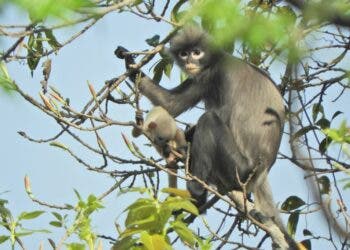New research into primate social structures offers insight into how human social life is organized.

Primates can develop quite complex social structures — just look at ours, we’re primates too. But exactly what made this family of species move towards a group rather than individual lifestyle? That’s what Luca Pozzi from the University of Texas at San Antonio (UTSA) Department of Anthropology, in collaboration with Peter Kappeler at the German Primate Center-Leibniz Institute for Primate Research, set out to understand.
The duo identified pair bonding as a key transition system between solitary and community lifestyles.
Our better halves
“The evolution of complex social systems in mammals, and more specifically in primates, is a challenging and exciting area of research. Our study shows that pair living—although rare—might have played a critical role in it,” says Pozzi.
“Living as a pair represents an evolutionary puzzle in the evolution of mammalian social systems because males could achieve higher rates of reproduction if they did not bond to a single female”.
Pozzi explains that social systems can work as an adaptive tool. Species need to adapt to their environmental conditions, he says, which is the same process that drives biological evolution. However, a modification of social behavior can accomplish the same goal at a much faster pace than natural selection. Among half of all primate species live in groups, he adds, while a third only form pairs; the rest (roughly one third) enjoy solitary lifestyles.
In order to understand what drives this behavioral adaptation process, which factors shape it, and how many times it occurred in the past, the team analyzed genetic data and behavioral observations of 362 primate species. The team found that the transition from a solitary way of life towards living in groups most often occurred through pair bonding. Thus, the propensity to form long-term pairs can be seen as the first step towards complex social structures, they explain.
There are two current hypotheses on the development of pair bonding, the team explains: the female spacing hypothesis and the paternal care hypothesis. The first hypothesis holds that “females pursue reproductive strategies that are not limited by the number of mates but by access to resources,” and that under certain conditions (such as high competition for food) females may spread out, limiting males’ ability to monopolize access to multiple females. The second one basically boils down to the idea that males may choose to focus on a single female because she either needs his help in raising the offspring (for protection, care, or provision) or to reduce the risk of strange males committing infanticide. Either way, the male in question enjoys greater net reproductive success even if he limits his mating opportunities. Evidence is mixed for both hypotheses, the team adds.
Up to now, the assumption was that these two hypotheses were mutually exclusive. But the team found that they were actually complimentary.
An initial ecological change led the females of a species to separate in space. Solitary males, which previously had several females living in their territory, were now only able to gain access to one female and started to invest more in their offspring to increase their chances of survival — thus reinforcing pair living. A further transition to group living was made possible through an improvement of the ecological situation, which allowed related females to live in close proximity once again, and they could then be joined by one or more males.
“However, the pair bond typical for humans within larger social units cannot be explained with our results, since none of our recent ancestors lived solitarily. Nevertheless, the advantages of paternal care also may have led to a consolidation of pair living in humans,” said Kappeler.
The paper “Evolutionary transitions towards pair living in non-human primates as stepping stones towards more complex societies,” has been published in the journal Science Advances.






